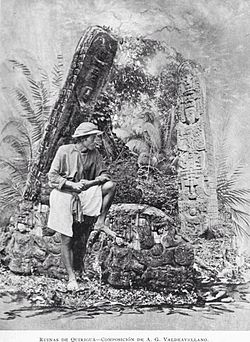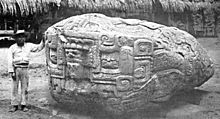Los Amates
Los Amates | |
|---|---|
 Quiriguá, Los Amates, in 1897. Picture fromAlberto G. Valdeavellano | |
| Coordinates:15°16′00″N89°06′00″W/ 15.26667°N 89.10000°W | |
| Country | |
| Department | Izabal Department |
| Settled | 30 June 1916 |
| Government | |
| • Mayor (2016-2020) | Milton Panteleón[1] |
| Area | |
| • Total | 405 sq mi (1,049 km2) |
| Elevation | 253 ft (77 m) |
| Population (2018 census)[2] | |
| • Total | 60,914 |
| • Density | 150/sq mi (58/km2) |
| Time zone | GMT_6 |
| Climate | Am |
Los Amatesis amunicipalityin theIzabal departmentofGuatemala.At the 2018 census, the population was 60,914. The mayor is currently Marco Tulio Ramirez Estrada. Los Amates is located on theMotagua River,6 kilometres (3.7 mi) from the ruins of the ancientMaya cityofQuiriguá.
History[edit]
Quiriguá[edit]
Quiriguáis an ancientMayaarchaeological sitein Los Amates. It is a medium-sized site covering approximately 3 square kilometres (1.2 sq mi) along the lowerMotagua River,[3]with the ceremonial center about 1 km (0.6 mi) from the north bank.[4]During theMaya Classic Period(AD 200–900), Quiriguá was situated at the juncture of several importanttrade routes.The site was occupied by 200, construction on theacropolishad begun by about 550, and an explosion of grander construction started in the 8th century. All construction had halted by about 850, except for a brief period of reoccupation in the EarlyPostclassic(c.900 –c.1200). Quiriguá shares its architectural and sculptural styles with the nearby Classic Period city ofCopán,with whose history it is closely entwined.[5]
After the Independence of Central America[edit]

The area was largely abandoned during the Spanish Colony of Guatemala, and the first European visitor to publish an account of Los Amates was English architect and artistFrederick Catherwood,who reached theQuiriguáruins in 1840, during the turbulent times of president generalRafael Carrera.[6]The previous landowner, by the surname of Payés, had related the existence of the ruins to his sons and to Carlos Meiney, aJamaicanEnglishman resident in Guatemala. The elder Payés had recently died and passed the land to his sons and, since neither Meiney nor Payés' sons had visited the land containing the ruins, they invitedJohn Lloyd Stephensand Catherwood to join them on their first trip to the site. Stephens had other duties to attend to, but Catherwood was able to accompany the Payés brothers to Quiriguá.[7]Due to adverse conditions he was only able to stay a short time at the ruins, but made drawings of two of the stelae, which were published with a short account of Catherwood's visit in John Lloyd Stephens's bookIncidents of Travel in Central America, Chiapas, and Yucatanin 1841.[6]A longer account of the ruins was made in 1854 by Dr. Karl Scherzer.
Explorer and archaeologistAlfred Maudslayvisited Quiriguá for three days in 1881; they were the firstpre-Columbianruins that he saw and they were sufficiently impressive to inspire him to take up a permanent interest in Central American archaeology.[7]He was able to return on three further occasions, the last being in 1894, and he made the first efforts to clear the monuments before recording them. He carried out a very thorough examination and made a photographic record of all visible monuments, carried out some minorexcavations,made paper and plastermoldsof the hieroglyphic inscriptions and surveyed the principal sculptures;[7]these molds were then shipped to theVictoria and Albert Museum,with casts being transferred to theBritish Museum.[8]
Los Amates train station[edit]

On 22 November 1896 the Northern RailroadZacapa, Zacapa-Puerto Barriosconnection, was opened to the public; it was the most important infrastructure project of generalJosé María Reina Barriosgiven the economic crisis the loomed over Guatemala if he was not able to finish the railroad on time for theCentral American Exposchedule for March 1897.[9]The new line would have one hundred and one miles.[9]In those days, the Northern region of Guatemala was practically a new and unexplored area, a newfound place where natural resources could be exploited and the railroad construction finally gave way to the commercial and industrial exploration of the area.[9]The complete linePuerto Barrios-Guatemala City-through Panajax- had one hundred and ninety seven miles and was built in stages (which later became train stops): from Puerto Barrios to Tenedores, eighteen miles; from Tenedores to Los Amates, forty one miles; from Los Amates toGualán,twenty one miles; fromZacapatoEl Rancho de San Agustín,thirty four miles; from El Rancho to Panajax, thirty miles; and finally, from Panajax toGuatemala city,thirty two miles.[9]
In 1910, theUnited Fruit Companybought Quiriguá, Los Amates and all the land for a great distance around forbananaproduction; they set aside 75 acres (30 ha) around the ceremonial centre as an archaeological park, leaving an island of jungle among the plantations.[10]More archaeological work was carried out from 1910 to 1914 byEdgar Lee HewettandSylvanus Morleyfor theSchool of American Archaeologyin Santa Fe.[4][10]Duplicates of the stelae of Quiriguá made from Hewitt's plaster casts of the originals were exhibited at thePanama-California ExpositioninSan Diego, California,in 1915.[10]The casts are still on display at theSan Diego Museum of Manin their "Maya: Heart of Sky, Heart of Earth" exhibition.[11][12]TheCarnegie Institutionconducted several intermittent projects at Quiriguá from 1915 through 1934.[10]
Municipality establishment[edit]
Los Amates municipality was established by an executive action of presidentManuel Estrada Cabreraon 30 June 1916, and ratified and organized on 24 June 1920. On 28 January 1944 the municipality capital was moved to Quirigua, but the change was brief as it was derogated on 12 April of that year.
United Fruit Company[edit]
In early 1920, after the Unionist party deposedManuel Estrada Cabrera,theUnited Fruit Company-which had received considerable concessions from the Guatemalan president in the past two decades inIzabal- was suddenly confronted with a large strike and did not have the help from the government to repress it due to thefighting taking place in Guatemala City.[13]New labor chapters opened both in Morales and Los Amates banana plantations, whilePuerto Barrioshad more than 250 members. The strike grew stronger and upon the resistance of the Unionists to help it, UFCO supported a coup d'état led by generalJosé María Orellanain 1921, who swiftly repressed the union members and gave tranquility to the United Fruit Company operations in Izabal.[14]
Franja Transversal del Norte[edit]
In the 1960s, the importance of the region known as Franja Transversal del Norte was in livestock, exploitation of precious export wood and archaeological wealth. Timber contracts we granted to multinational companies such as Murphy Pacific Corporation from California, which invested US$30 million for the colonization of southern Petén and Alta Verapaz, and formed the North Impulsadora Company. Colonization of the area was made through a process by which inhospitable areas of the Franja Transversal del Norte (FTN) were granted to native peasants.[15]
In 1964, the National Institute for Agrarian Transformation (INTA) defined the geography of the FTN as the northern part of the departments of Huehuetenango, Quiché, Alta Verapaz and Izabal and that same year priests of theMaryknollorder and the Order of the Sacred Heart began the first process of colonization, along with INTA, carrying settlers from Huehuetenango to theIxcánsector in Quiché.[16]
The Northern Transversal Strip was officially created during the government of General Carlos Arana Osorio in 1970, by Decree 60-70 in the Congress, for agricultural development.[17]The area included within the municipalities: San Ana Huista, San Antonio Huista, Nentón, Jacaltenango,San Mateo Ixtatán,and Santa Cruz Barillas inHuehuetenango;ChajulandSan Miguel Uspantánin Quiché;Cobán,Chisec,San Pedro Carchá,Lanquín,Senahú,CahabónandChahal,in Alta Verapaz and the entire department ofIzabal.[18]
Climate[edit]
Los Amates has atropical monsoon climate(Köppen:Am) and its municipal capital is 78 m above sea level.[19]
| Climate data for Los Amates | |||||||||||||
|---|---|---|---|---|---|---|---|---|---|---|---|---|---|
| Month | Jan | Feb | Mar | Apr | May | Jun | Jul | Aug | Sep | Oct | Nov | Dec | Year |
| Mean daily maximum °C (°F) | 28.1 (82.6) |
29.7 (85.5) |
32.0 (89.6) |
33.3 (91.9) |
33.3 (91.9) |
32.6 (90.7) |
31.3 (88.3) |
32.0 (89.6) |
32.2 (90.0) |
30.8 (87.4) |
28.7 (83.7) |
28.1 (82.6) |
31.0 (87.8) |
| Daily mean °C (°F) | 23.9 (75.0) |
24.7 (76.5) |
26.5 (79.7) |
27.7 (81.9) |
28.2 (82.8) |
28.0 (82.4) |
27.2 (81.0) |
27.6 (81.7) |
27.6 (81.7) |
26.6 (79.9) |
24.8 (76.6) |
24.2 (75.6) |
26.4 (79.6) |
| Mean daily minimum °C (°F) | 19.8 (67.6) |
19.7 (67.5) |
21.1 (70.0) |
22.1 (71.8) |
23.2 (73.8) |
23.4 (74.1) |
23.2 (73.8) |
23.2 (73.8) |
23.1 (73.6) |
22.4 (72.3) |
21.0 (69.8) |
20.3 (68.5) |
21.9 (71.4) |
| Averageprecipitationmm (inches) | 98 (3.9) |
52 (2.0) |
60 (2.4) |
53 (2.1) |
163 (6.4) |
292 (11.5) |
273 (10.7) |
226 (8.9) |
310 (12.2) |
208 (8.2) |
174 (6.9) |
136 (5.4) |
2,045 (80.6) |
| Source: Climate-Data.org[19] | |||||||||||||
See also[edit]
 Guatemala portal
Guatemala portal Geography portal
Geography portal- Franja Transversal del Norte
- Izabal Department
- Quiriguá
- Tragic Week (Guatemala)
- United Fruit Company
Notes and references[edit]
References[edit]
- ^Canal Antigua (2015)."TSE presenta resultados oficiales de alcaldes en Izabal".Canal Antigua(in Spanish). Guatemala. Archived from the original on September 14, 2015.Retrieved13 September2015.
{{cite news}}:CS1 maint: unfit URL (link) - ^Citypopulation.dePopulation of departments and municipalities in Guatemala
- ^Ashmore, Wendy (1980)."The Classic Maya Settlement at Quirigua: Recent agricultural activities have helped reveal the extent of the buried settlement"(PDFonline publication).University of Pennsylvania Museum of Archaeology and Anthropology.p. 24.Retrieved20 August2009.
- ^Miller, Mary Ellen(1999).Maya Art and Architecture.London and New York:Thames & Hudson.p.49.ISBN0-500-20327-X.OCLC41659173.
- ^abStephens, John Lloyd; Catherwood, Frederick (1854).Incidents of travel in Central America, Chiapas, and Yucatan.London,England:Arthur Hall, Virtue and Co.
- ^abcKelly 1996,p. 243
- ^Trustees of the British Museum (n.d.)."Alfred P. Maudslay (1850–1931)".The British Museum: Explore/Highlights.Trustees of the British Museum.Archived fromthe originalon 20 January 2009.Retrieved10 February2009.
- ^abcdLa Ilustración Guatemalteca (15 December 1896)."La Línea del Norte".La Ilustración Guatemalteca(in Spanish). Guatemala: Síguere, Guirola y Cía.: 154.
- ^abcdKelly 1996,p. 244
- ^San Diego Museum of Man(n.d.)."Casts of our Maya Monuments".San Diego Museum of Man.Retrieved16 June2010.
- ^— (n.d.)."Maya: Heart of Sky, Heart of Earth".San Diego Museum of Man.Retrieved16 June2010.
- ^Prins Wilhelm(1922).Between two continents, notes from a journey in Central America, 1920.London, UK: E. Nash and Grayson, Ltd. pp. 148–209.
- ^Colby, Jason M. (2011).The business of empire: United Fruit, race and U.S. expansion in Central America.Cornell University Press. p. 143.ISBN9780801462726.
- ^Solano 2012,p. 12.
- ^Solano 2012,p. 13.
- ^"Franja Transversal del Norte".Wikiguate.Archived fromthe originalon 31 October 2014.Retrieved30 October2014.
- ^Solano 2012,p. 15.
- ^ab "Climate: Los Amates".Climate-Data.org.Retrieved5 September2015.
- ^abcSEGEPLAN."Municipios de Izabal, Guatemala".Secretaría General de Planificación(in Spanish). Archived fromthe originalon 5 July 2015.Retrieved5 July2015.
Bibliography[edit]
- Kelly, Joyce (1996).An Archaeological Guide to Northern Central America: Belize, Guatemala, Honduras, and El Salvador.Norman:University of Oklahoma Press.ISBN0-8061-2858-5.OCLC34658843.
- Solano, Luis (2012).Contextualización histórica de la Franja Transversal del Norte (FTN)(PDF)(in Spanish). Centro de Estudios y Documentación de la Frontera Occidental de Guatemala, CEDFOG. Archived fromthe original(PDF)on 13 November 2014.Retrieved31 October2014.



